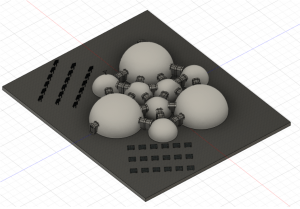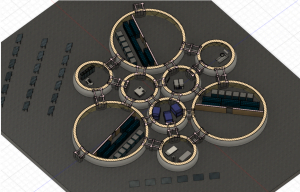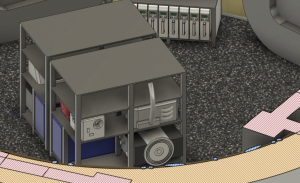Moon Camp Pioneers Gallery 2020-2021
In Moon Camp Pioneers each team’s mission is to 3D design a complete Moon Camp using Fusion 360. They also have to explain how they will use local resources, protect astronauts from the dangerous of space and describe the living and working facilities.
Team: Dark side of the cheese
UTC Portsmouth Portsmouth United Kingdom 16
External viewer for 3d project
|
Project description
Our Lunar base mission will be split into 4 initial stages: In Stage 0 a small team would be sent up to set up an automated Laser Sintering 3D printer before returning home, to produce bricks necessary for building the base and in a separate mission setting up the small nuclear reactor with a few specialists Stage 1 will include 2 rockets, 1 sending up building resources (frames, tents and airlocks) and the other bringing the initial crew – using the easily constructible frameworks and printed bricks (continually produced between the missions) they can build the 3 initial centre domes. Stage 2 will include more building materials to produce 3 larger outer domes to expand the base, also resources to sustain the crew and for research such – more people will come in the 3rd and final rocket of Stage 2 to complete the full crew. Stage 3 will be, a relief crew would be sent up to replace the initial crew who went up in Stage 1 as well as any equipment or materials requested by the crew – this payload will act as a response to any issues or necessities only identifiable by the crew to ensure that any unforeseen issues have a place in the plan to be solved. All payloads will be delivered by Arian 5 rockets as they have an ideal capacity and the functionality of dual payloads when equipment is being sent alongside crewmembers. |
|||
|
Where do you want to build your Moon Camp?
Our lunar base will be situated near Stöfler, which is a crater in the Southern highlands. The south side has sunlight most of the day, this provides us with power through the solar panels as well as light to carry out tasks throughout the day. Because of craters in constant darkness, there’s access to moon ice which is an important resource especially in the later stages of the bases’ operation (to make rocket fuel). As our base’s ultimate goal is to become a rocket launch base), being on the south side allows the rockets to perform a slingshot manoeuvre around the earth as they set off for their journey out into the solar system. This will give the craft a large boost in speed without using much fuel, making the launches even more efficient. How do you plan to build your Moon Camp? Describe the techniques and materials you would use.
Our Moon Camp will be modular so that new structures can be easily added as the base expands. Each Structure made of 3 layers (view in our model with the section analysis) and airlocks for exits and entrances. The Inner layer will be PVC coated polyester (inspired by mountaineering tents and airtight greenhouses) as it can easily clip to layer 2 and is completely airtight – so can be pressurized and become living space for the crew. The 2nd layer will be a metal frame of triangles making a dome as arcs are the strongest shape and triangles are sturdy and easy to construct. The metal frame can be hand-constructed from 50mm diameter aluminium poles by crewmembers in space suits. The 3rd and final layer will be a stone dome of bricks produced with lunar soil they’ll be easy to assemble with interlocking shapes and support themselves outside the metal frame – they will be made by automated SLS Regolith printing robots programmed to produce them while left on the moon after Stage 0 so bricks are ready for Stage 1. After the initial 4 stages, there will be 6 domes with 6m diameter and 3 with 12m diameters. The small 6 will be for: A kitchen, power & oxygen control, living quarters, gym, communications center and med bay. The larger 3 will each be divided in half by the polymer (so airtight) with half of each being for Algae & hydroponic and the other 3 halves being a workshop, laboratory and storage area. The environment on the Moon is very dangerous for the astronauts. Explain how your Moon Camp will protect them.
The number 1 priority regarding the design of the moonbase is the safety of the crew. The base’s structures are made of domes which are naturally the strongest to ensure longevity as well as protecting the crewmembers from any asteroid showers or space debris. The inner tent material is a strong and coated polyester to ensure no rips or leaks. The moon’s surface radiation levels are roughly 200 times that of Earth’s due to its lack of atmosphere blocking out CMBR – this is why the outer bricklayer of the dome is as thick as it is (500mm) as it will absorb most radiation and any more will be stopped by the tent (which will be reflective). Finally is the absolute lack of single-point failures – all domes have multiple access routes, solar energy with nuclear backup, Oxygen Generation System and Algae – no single failure could break the system. Explain how your Moon Camp will provide the astronauts with:
|
|||
|
Water
|
Food
|
Electricity
|
Air
|
|
The majority of the water will come from the water reclamation system (WRS), which collects ambient water (condensation and humidity) as well as urine. Water is also created in a Sabatier system; combining the hydrogen produced by the OGS (see 2.4 D) with carbon dioxide to produce water (heat and methane). This water can now be used for any number of uses. The heat can be used to heat the base and the methane stored to be used as a fuel. The other water for the algae ponds, a fresh supply of water to mix into the system and later used in the production of hydrogen and oxygen for rocket fuel; will come from the ice deposits on the moon. |
During the initial stages of the mission, the astronauts will live off of rations sent up with them from Earth. These supplies will be replenished with the other landings necessary for the mission. In stage one, one of the three ‘Agro domes’ will be created on the moon. These house hydroponics bays (amongst other things) in which the necessary food required to fuel the lunar base can be grown. The following stages will bring the infrastructure required for the other two bays. However, a regular supply of rations from Earth will still be brought up to act as both a fail-safe and to top up the astronaut’s minerals and salt. Hydroponics allows the astronauts and ground teams to control crop growth almost entirely, timing harvests and providing nutrients for fruitful growth. The crops grown will be genetically modified to grow larger and faster than naturally occurring crops; maximising food production. |
Most space operations are powered by solar panels, they’re excellent. They are also more effective in space than on earth as there is no atmosphere to reduce light intensity. Once complete our lunar base will use three solar panel arrays alongside a small nuclear reactor, a fast-neutron reactor (FNR), using a Na-K-C coolant. As it functions reliably (in space) eliminating risk off SCRAM (or meltdown). It provides another layer of protection to power loss in the event of a failure, on top of the three separate solar panel arrays. As well as providing the baseload energy demand. It will be set up in a nearby crater which will both act as a shield in an accident but also keep the reactor in shade, aiding cooling. By the time the FNR reactor needs to be replaced, emerging technologies like a nuclear- battery-reactor-hybrid have potential to be even more effective. |
The majority of air is recycled, using an Oxygen generation system (OGS). This system uses electrolysis to split water into oxygen and hydrogen. The hydrogen produced is used in the WRS (see 2.4 A). This is the system used on the ISS and has been used in submarines for over 50 years. Meaning it’s tried, tested and all its major flaws that only appear in practice have been ironed out. Systems can never be perfect and there’s bound to be air losses, the ISS deals with these by having oxygen deliveries from the earth. However, we will replenish the oxygen with algae tanks in the base. Both of these systems will work together to provide a sufficient breathable air supply for the crew. If there is a breach of the base the leaking areas can be isolated as all the doors are airtight. |
|
Explain what would be the main purpose of your Moon Camp (for example: commercial, scientific, and/or tourist purposes).
The purpose of our mission is to establish a self-sustaining base on the moon as a prerequisite for a Space Travel Refueling Station. In the future, we will be aiming to reach further and further out into our galaxy to research, explore and possibly inhabit new celestial bodies in the universe. During space travel (for example lunar and mars launches) the majority of the fuel is used to escape the atmosphere of Earth and that greatly reduces the range of the spacecraft. Our base will be used to stop and refuel after escaping earth before launching again and travelling to wherever the craft is going. This is why our base design is highly modular so it can be expanded to a larger port with refuelling facilities after the initial 4 Stage mission. |
|||
|
Describe a day on the Moon for your Moon Camp astronaut crew.
Our aim is for a day on the moon for our crew to closely reflect a working day on Earth in order to help the crew adjust more easily and quickly to the new environment as well as reduce the feeling of abnormality from their terrestrial lives. Days will start off with exercise in the gym – which will contain a treadmill with a bungee harness to simulate stronger gravity – followed by breakfast in order to get people energized for the day after that the crew would meet for a morning briefing from the commander as well as any notices from the crew or mission control. Following that would be each crew members morning task or tasks which would depend on their individual roles In the 1st stage of the mission there will be 4 crewmembers: A commander who also specializes in botany, a medic and 2 engineers – example jobs could be setting up new structures for the next stages, maintenance of the base or equipment or monitoring hydroponics (in later stages). In stage 2 the crew will be filled by adding another (more specialized) botanist (as the commanders leadership role is their main priority) a research scientist and another engineer as construction and maintaining the equipment is so essential to the mission. After morning tasks will be a lunch period and some free time depending on how many /how urgent jobs are during that particular day. Then would come afternoon tasks that would (just like in the morning) depend on the individual roles of crewmembers. Research tasks would be important as our base will need to carry out extensive tests to fulfill its purpose as a prerequisite to a spacecraft stop but also groups around the world interested in lunar research such as universities could submit requests for tests and samples similar to how the ISS supports global research as well as providing a secondary source of funding for the lunar base project. We intend for the day to remain consistent however we are adamant that scheduling decisions should be made on a case by case basis as responding to new and unforeseen developments is so essential to thriving off planet so breaks and other time slots can be sacrificed and reimbursed at a later date if necessary. After the tasks of the day are complete crewmembers will have dinner and free time to relax and enjoy themselves before sleeping. |
|||





